WNA, 1975년 설립 원자력사업자와 기관, 대학 등 175개 회원사 국제적 민간기
[다음은 아그네타 라이징(Agneta Rising) 세계원자력협회(WNA, World Nuclear Association) 사무총장(Director General)과의 일문일&

“The World Nuclear Association represents more than 170 member companies from around the world. We are the only industry organization with a global mandate to communicate about nuclear energy. The Association’s mission is to promote a wider understanding of nuclear energy among key international influencers by producing authoritative information, developing common industry positions, and contributing to the energy debate. The World Nuclear Association is committed to ensuring that the nuclear industry is best represented in all forums where its interests are at stake; enabling co-operation between its members; and communicating the benefits of nuclear energy in order to improve the market environment and secure greater support from key stakeholders. We promote nuclear energy by engaging with key global stakeholders on topics of strategic importance to nuclear development. We represent the global nuclear industry in key international forums. We provide the latest and most reliable nuclear information, including the Information Library of our website and World Nuclear News, the daily news service and we develop industry positions and reports on the issues that matter through our members groups.”
Q2. On cooperation with international organizations such as IAEA, which area are you involved in and how do you deal with that (or those).
“We seek to represent the views of the global nuclear industry through cooperation with many international organizations. We work with the IAEA on a wide range of different topics. We have taken part in the consultation exercises for the International Energy Agency’s World Energy Outlook, the IEA-Nuclear Energy Agency’s Nuclear Energy Technology Roadmap, and the World Bank’s new Environmental and Social Framework. The Director Genera /I was invited to the World Energy Council Executive Assembly. We are working with the International Chamber of Commerce to enable effective participation as part of the business delegation at the COP 21 climate change meeting in Paris. One special area of cooperation is the World Nuclear University. This is a global collaboration between the IAEA, WANO, the OECD-NEA and the World Nuclear Association to enhance nuclear education and build nuclear leadership.”
Q3. The reports published by WNA such as the nuclear fuel market report (Global Scenarios for demand and supply) are influenced to the nation’s nuclear policy including Korea and some countries which want to develop nuclear energy. Please tell me about the view of world nuclear power industry after year 2016.
“The global potential for the nuclear power industry is very promising. The number of reactors currently under construction around the world is at levels not seen for twenty years. Demand for new nuclear power plants and the fuel cycle services that support them will rise over the coming decades, as pressure increases to provide reliable and affordable electricity supplies without the production of harmful levels of greenhouse gas emissions. However, changes will be necessary to meet this demand. Nuclear power plants, both new build and operating, need fair markets that value each generation option on their merits and support long-term decision making to ensure security of supply. Regulation needs to be fit for purpose and a more holistic view of safety must be applied so that all options are scrutinized equally. Unless the right policies and measures are put in place the full potential for the world’s nuclear industry will not be realized.”
Q4. The Power Plant is divided 2nd generation type and 3rd generation type and these days world nuclear industry’s agenda is “More safe nuclear power plant “after nuclear accident in Fukushima. So the 4th generation type power plant such as SER, WHTR and SCWR and GFR and SMR are regarded as promising stability and economic feasibility. What is your evaluation about it?
“New technologies, including those called fourth generation plant, offer new options for deployment of nuclear generation, through innovative fuel cycles, or through smaller plant that could be used for a greater range of situations on the grid. But it should always be borne in mind that all nuclear reactors, current and future, are very strictly regulated to ensure their safety. In addition to technological innovations being introduced in reactors currently under construction, existing reactors benefit from new technology too. Reactors across the world have undergone “stress tests” since the Fukushima accident to identify where any improvements are required.“ 
“The uranium market has shown itself able to respond to market demand. In recent years exploration has increased our knowledge of the world’s uranium resources, and further exploration is likely to reveal new deposits. This will help meet demand for many decades to come. Nuclear technology also has the advantage of having ways to make greater use of our uranium resources. Recycling through reprocessing, fast reactors and exploring the use of thorium all mean that a much greater share of the world’s electricity could be supplied from nuclear energy for many decades to come.”
Q6. The climate change caused by fossil fuel is the big issue we have to sort out for the future. Therefore, WNA are emphasizing on the role and importance of clean nuclear energy which has low carbon emission. However, anti-nuclear organizations like Greenpeace insist that nuclear energy is no longer economical energy source if the cost of decommissioning, disposal for used nuclear fuel and compensation for nuclear accident are added to power generating cost after Fukushima accident. What is your opinion against that?
“Nuclear energy has a vital role to play in the fight against climate change. That’s not just the view of the World Nuclear Association. The OECD’s IEA/NEA two degree scenario projects nuclear energy making the largest contribution to electricity supply of any single electricity generation technology. Nuclear generators are typically required to make provisions for decommissioning and management and disposal of used fuel. These costs are a relatively small fraction of the overall generation costs of nuclear energy. In fair markets nuclear is a competitive generation option.”

“South Korea gets around a third of its electricity from nuclear generation. It has developed its own expertise in nuclear technology and has the potential to be an important playing in the international nuclear vendor market. The construction of the Barakah nuclear power plant in Abu Dhabi is proceeding well. There have been problems with falsified documents recently. Steps should – and are – being taken to address these issues; it is important that South Korea realizes that these problems do not detract from benefits that nuclear energy can bring in terms of providing reliable, affordable and clean energy. For Japan, despite the Fukushima accident it is still planned that nuclear generation will supply more than a fifth of Japanese electricity by 2030. While reactors have been shut down Japan has been relying on expensive imported fossil fuels. For the Japanese nuclear industry the important task has started of returning those reactors suitable for restart to full operation. It is important that the industry can demonstrate that it deserves the trust of the Japanese population. China is making impressive progress in the development of its nuclear energy. Almost thirty reactors are in operation, with 58 GW planned for early next decade, rising to maybe 130 GW by 2030. China has achieved this progress through international cooperation. It has worked with a wide range of reactor vendors when developing its own domestic nuclear capacity. It is now partnering with companies to invest in nuclear energy around the world and offering its own reactor technology. The World Nuclear Association is a vital forum for providing opportunities for the companies of the global industry to meet and develop these important international projects and partnerships.”
Q8. Most of nuclear power plant located within a radius of 1000km with Seoul as a center. Especially China is constructing 48 unite of nuclear power plant according to the policy of China and 200 unit of nuclear power plant will be operate in year Eastern Asian countries. So cooperation is needed each countries to keep safety of nuclear power plant. But even though all of them having regional and cultural likeness, it is very difficult caused by having confrontation with politic, foreign affairs and business. So do WNA become a bridge between 3 countries as non-governmental interchange?
“One of the World Nuclear Association’s primary roles is to help connect the global nuclear industry with various stakeholders, including government and the public. We do this via our public communication channels and through our working groups and conferences. While the safety of nuclear power plants is an important topic, there are many expert bodies which already specialize in this area. It needs to be recognised that nuclear energy facilities offer many valuable benefits to the countries where they are located – providing reliable clean energy and keeping power bills low. This is good news for all neighbouring countries Our mission is to help promote the use of this remarkable technology. If there is a way we could help Asian government cooperate to improve their nuclear energy programs and maximize these benefits then we would certainly consider it.”
Q9. The decommissioning skills of nuclear power plant are blue ocean in world nuclear industry. Korean government announced the decommissioning of 1st unit of KORI nuclear power plant (Operation is 10 years, Life extension is 30 years) and start to develop high technologies about it. But advanced countries having those technologies like USA and Russia, etc carry forward to extend a life extension to maximum 20 years more after 40 years operation. Russia strive a developing technology to use more 100 years. Do you think decommissioning industry of nuclear power plant become a blue ocean business?
“There is certainly a lot of growth in the nuclear plant decommissioning market expected over the coming decades. It is clear that technology and skills in this area are constantly improving. While this is certainly a good thing, we would note that it is no reason to close well-performing, safe nuclear power plants ahead of schedule. All countries/operate should seek to extract as much value as they can out of their existing nuclear power plants. They are long term assets requiring substantial upfront investment but they pay back over the long term. Nuclear plants generally provide more value – financial and environmental – to both operators and society the longer they operate.”
Q10. The EDF energy in France become a priority foreign company in construction project of Hinkley Point C nuclear Power plant according to the World Nuclear News. The point is EDF energy consortium with China. In the past few years, the joint bidding like cooperation with technology and capital become a new trend. what do you think about this trend?
“Some market structures suit having multiple project partners more than others so this will differ country by country. At a very general level it makes sense to include various partners in a major project since this allows the risks to be spread. Different companies will bring different expertise to the table and will be suited to handling some project risks than others. There are challenges also in these tie-ups, as all the partners must be able to get along with each other. Having international partners arguably increases the benefit, although also introduces extra challenges in terms of language, culture, different codes and standards and regulation etc. The nuclear industry is truly an international one in many ways and we believe that international project partnerships are positive developments, offering benefits to all sides. China, like South Korea, boasts an impressive nuclear construction record at home and there are surely lessons that European and American companies can learn from them. For Asian countries it should increase export opportunities in the future.”
Q11. Reinforcing Safety is a big issue after Fukushima accident. What are important things in order to reinforce nuclear safety? Moreover, what is the role of WNA to make strong safety culture in nuclear industry?
“We believe that the Fukushima nuclear accident has created the need for at least two major changes in how industry, governments and regulators approach nuclear safety. The first of these is that we desperately need to stop treating nuclear accidents as if they are uniquely dangerous. Radiation released from the Fukushima accident is not expected to directly result in any measurable health effects according to the international expert body UNSCEAR. By contrast, there are clearly major negative psychological impacts due to excessive fear of radiation. Also, many of the protective measures introduced following the accident, especially the prolonged evacuation, have given rise to high social and economic costs. These findings are very similar to the Chernobyl accident, which also resulted in very few radiation related fatalities but large socio-economic impacts. The lesson needs to be learned by all government with nuclear energy programs and their neighbours. Industry should try to improve public understanding of radiation, while governments and regulators need to set in place policies now which reflect these lessons and seek to minimize ALL accident impacts in the future. The World Nuclear Association is actively trying to improve understanding of radiation amongst key stakeholders. We are also working with various expert groups in efforts to improve the current public radiation protections system. The second major thing is that industry and regulators need to change their thinking and language about nuclear accidents. Put bluntly, we have to accept that there is a good chance that a nuclear accident will happen again somewhere in the future. Of course industry must work hard to prevent this, but we must never again fall into the trap of the ‘safety myth’. I.e. we cannot become complacent and believe that any nuclear technology or design is ‘fool-proof’, even if we substantially upgrade it. There have been two major accidents now and, as noted, the radiation-related health impacts have been very small. The question is how do we make ALL the impacts (radiation health effects, psychological, social and economic) from a future accident are even smaller? Traditionally, the ‘zero-tolerance’ attitude means that there has been a lot of investment in accident prevention, but less in accident mitigation and response measures. There are a lot of improvements which can be potentially made in this area and we are exploring what can be done effectively. If we want to normalize nuclear technology among the public then we need to treat it normally ourselves. This means that we need to stop pretending that nuclear accident can never happen again and also stop pretending that they are particularly dangerous.”
Q12. The final aims are permanent disposal of used nuclear fuels. However it is very tough issue to make a permanent place for the used nuclear fuels. Korea finished 1st step business for the low - and intermediate-level radioactive disposal and will finish a surface disposal facility as 2nd step business till on December year 2019 and final aims are making place high-level radioactive waste. If we don’t make a facility to handle a high-level radioactive waste, we may stop an operation of nuclear power plant. What kind of policies in overseas advanced countries about the way of handling of used nuclear fuels? As well as what is an idealistic solution to lead of public acceptance?
“The ‘volunteerism approach’ has been reasonably successful in finding sites for waste repositories in Europe (especially Sweden). In this process the government opens up the hosting of such a facility to bids from interested communities who may even compete with each other. This process generally creates a very different response to when a government simply decides a site based on its own criteria and then has to justify this selection to a local community who may not have been properly consulted. Whatever approach is chosen, early and ongoing public engagement is key. If there was a country willing to host a multi-national repository then this could make a lot of economic sense and such a proposal should be looked at closely. Many members of the public look on recycling very favourably since they know this reduces waste and allows useful material to be re-used. Of course recycling nuclear material has the same effect and if it aligns with public values it may improve the acceptability of nuclear waste and its treatment and disposal. We are pleased to see that South Korea is keen to develop a fast reactor program in the future.”

“If the world is to seriously have a chance at avoiding a 2 C rise in temperature then the World Nuclear Association believes that there will need to be a dramatic increase in the use of nuclear energy. Realistically it should reach levels of about 25% of all electricity consumed globally. This will require the addition of about 1000We of nuclear capacity – over twice that which is installed today. This is clearly an ambitious target, but it is also very achievable if we look at the peaks in historic nuclear construction rates. Ultimately fighting climate change effectively requires all low carbon technologies to work together in harmony. This means that different countries and competing energy sectors should cooperate to exchange knowledge and expertise and to learn from best practice. The South Korean nuclear industry has come of age and has a major role to play in helping other countries to introduce clean, reliable nuclear energy.”

